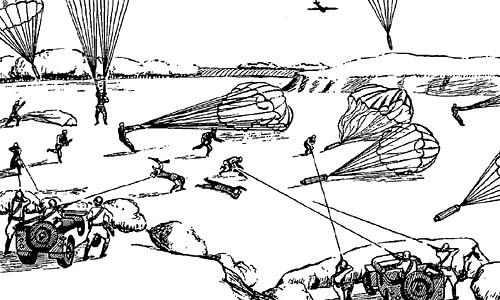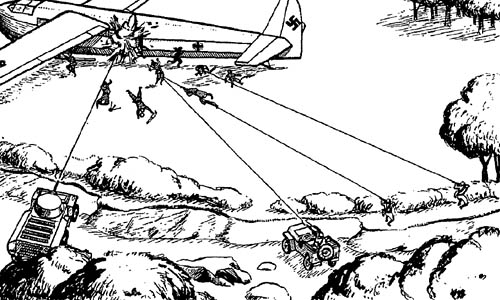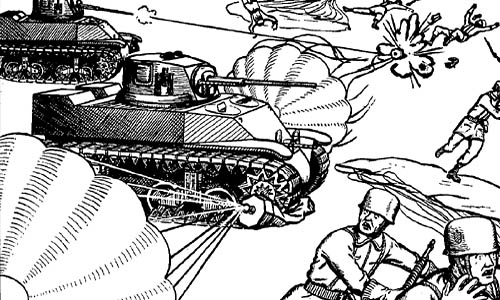A guide to defense against airborne troops from Cavalry Mechanized Reconnaissance Squadron, Cavalry Field Manual FM 2-30, U.S. War Department, Washington, DC, March 1943:
ANTIAIRBORNE DEFENSE
The reconnaissance squadron is a highly effective agency in the scheme of antiairborne defense as outlined in FM 100-5. Generally speaking, airborne troops in force will be used either ahead or to the flank of their enemy for the purpose of seizing and holding key terrain or behind it as a vertical envelopment. In either case, the squadron has an active role.
a. The squadron operating ahead of the division will, in all probability, be the nearest element to any point at which an air landing is attempted in the division zone of advance. The points at which such an enemy operation will be profitable should be as well known to friendly commanders as they are to the enemy and should therefore be expected. Long-range air reconnaissance may further reduce the element of surprise. Division G-2 should immediately warn the reconnaissance squadron commander of any airborne movements observed either in preparation or aloft. Being thus alerted, the squadron commander can plan how he will oppose a landing at any probable point in his zone.
(1) The reconnaissance commander encountering airborne troops in his zone must make a rapid decision based on the stage of the enemy development, relative strength, and the urgency of his primary mission. He may decide to attack, to contain the force until reinforced by the division, or to bypass and report the incident.
(2) If the commander decides to attack, the action is characterized by its rapidity and dispersion. Defense against light bombardment and fighter aircraft supporting the landing is accomplished by use of overhead cover, wide dispersion of vehicles, and fire of antiaircraft machine guns. Parachutists, after they have jumped, and gliders and transports making a landing approach should be fired on from the time they come within effective range until they are destroyed. Parachutists should be prevented, if possible, from reaching and opening the containers of heavy weapons dropped with them, and glider or transport prevented from unloading their heavy weapons. High explosive, 37-mm fire, is effective against gliders and transports on the ground. Weapon containers may be destroyed by gunfire or by the light tanks running over them.
b. When the squadron is in reserve it may be assigned the mission of defense against airborne attacks aimed at rear installations.
(1) The squadron commander, in cooperation with G-2 and G-3, makes preparation for the employment of his command. The squadron is included in the warning system or, if one has not been established, he assists in its creation and provides radio-equipped motor patrols. A reconnaissance of the rear area is made to discover and study likely objectives for airborne attack. Based on this study, plans are made for the employment of the squadron to include communication, priority on roads, and support by reserve elements of the division.
(2) The enemy planning to attack in rear of the division will take cognizance of the fact that the area probably is more or less organized for resistance and he will attempt deception by means of feints and demonstrations. One solution to this problem is to divide the rear area into three reconnaissance troop sectors, locating each troop in the position from which it can move most readily to the probable points in its sector. The squadron, less detachments, should remain in centrally located reserve prepared for rapid movement to any sector.
(3) The actual engagement of the airborne troops is as previously described.













Tanks – run away!!!